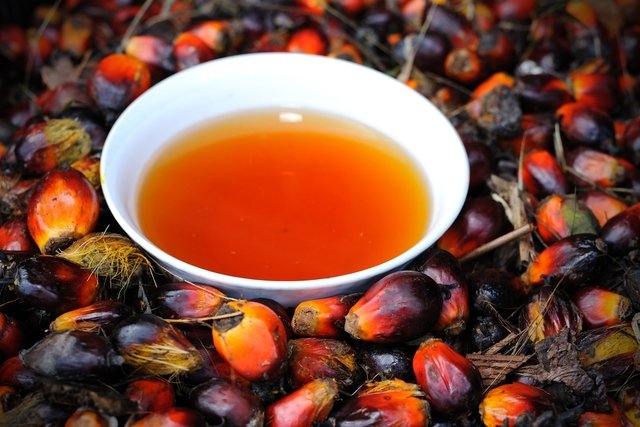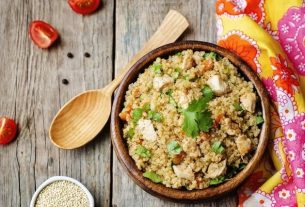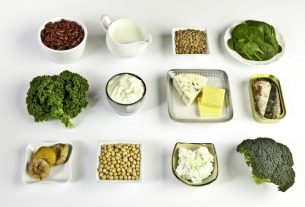Palm oil, also known as palm oil or dendê oil, is a type of vegetable oil, which can be obtained from the tree popularly known as oil palm, but whose scientific name is Elaeis guineensis, rich in beta-carotene, a precursor of vitamin A, and vitamin E.
Despite being rich in some vitamins, the use of palm oil is controversial, because the health benefits are not yet known and because the process of obtaining it can have a major impact on the environment.
On the other hand, because it is economical and versatile, palm oil is widely used in the manufacture of cosmetic and hygiene products, such as soap and toothpaste, and food products, such as chocolates, ice cream and other foods.

Main benefits
Palm oil is a source of omega 6 and 9, vitamin A and vitamin E and, therefore, may have some health benefits, the main ones being:
- Promotes skin and eye health;
- Strengthens the immune system;
- Improves the functioning of reproductive organs;
- It is rich in antioxidants, acting directly on free radicals and preventing premature aging and the development of diseases.
Raw palm oil can be used to season or fry food, as it is stable at high temperatures, and is part of the cuisine in some places. However, when this oil goes through the refinement process, it loses its properties and starts to be used as an ingredient in the manufacture of industrialized products. of cholesterol.
Palm oil can also be used in cocoa or almond butter as a stabilizer to prevent the product from separating. Palm oil can be identified on product labels under various names, such as palm oil, palm butter or palm stearin.
How to use palm oil
The use of palm oil is controversial, as some studies indicate that it may have health benefits, while others indicate that it does not. However, ideally, your consumption should be regulated to a maximum of 1 tablespoon of olive oil per day, always accompanied by a healthy diet. Furthermore, you should avoid consuming industrialized products that contain it, and always pay attention to the food label.
There are other healthier oils that can be used to season salads and foods, such as extra virgin olive oil, for example. Learn how to choose the best olive oil for health.
Nutritional information
The following table indicates the nutritional value of each substance present in palm oil:
How palm oil is made
Palm oil is the result of crushing the seeds of a type of palm tree found mainly in Africa, the oil palm. To prepare it, it is necessary to collect the fruits of the palm tree and cook them using water or steam, which allows the pulp to be separated from the seed. Then, the pulp is pressed and the oil is released, having the same orange color as the fruit.
To be commercialized, this olive oil goes through a refinement process, in which it loses all its vitamin A and E content and which aims to improve the organoleptic characteristics of the oil, mainly the smell, color and flavor, in addition to making it it more ideal for frying food.
Controversies over palm oil
Some studies show that refined palm oil may contain some carcinogenic and genotoxic compounds known as glycidyl esters, which are produced during the refinement process. Furthermore, during this process the oil loses its antioxidant properties, however more studies are still needed to prove this.
It was also found that the production of palm oil can cause damage to the environment due to deforestation, extinction of species, excessive use of pesticides and increased CO2 emissions into the atmosphere. This is because this oil is not only used in the food industry, but also in the manufacture of soaps, detergents, biodegradable fabric softeners and as fuel in cars that run on diesel.
For this reason, an association called The Roundtable on Sustainable Palm Oil (RSPO), which is responsible for making the production of this oil more sustainable.
Bibliography
- CAMPINAS STATE UNIVERSITY . Brazilian Food Composition Table – TACO. 2011. Available at: <http://www.nepa.unicamp.br/taco/contar/taco_4_edicao_ampliada_e_revisada.pdf?arquivo=taco_4_versao_ampliada_e_revisada.pdf>. Accessed on January 15, 2020
- BESSOU Cécile, PARDON Lénaïc. Environmental Impacts of Palm Oil Products: What Can We Learn from Life Cycle Assessment?. Palmas Magazine. 37. 225-234, 2016
- FACTOR Elena, FANELLI Roberto. Palm oil and palmitic acid: a review on cardiovascular effects and carcinogenicity. International Journal of Food Sciences and Nutrition. 64. 5; 648-659, 2013
- MBA Ogan, DUMONT Mary-Joseph, GADI Michael. Palm oil: Processing, characterization and utilization in the food industry – A review. Food Bioscience. 10. 26-41, 2015

Sign up for our newsletter and stay up to date with exclusive news
that can transform your routine!
Warning: Undefined array key "title" in /home/storelat/public_html/wp-content/plugins/link-whisper-premium/templates/frontend/related-posts.php on line 12
Warning: Undefined array key "title_tag" in /home/storelat/public_html/wp-content/plugins/link-whisper-premium/templates/frontend/related-posts.php on line 13




